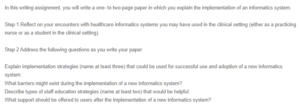Implementing Informatics Systems in a Clinical Setting
In my job in healthcare, particularly in an emergency room, I have come across a number of healthcare informatics systems that have had a substantial impact on the delivery of treatment. Several ways can be used to successfully install a new informatics system in a clinical setting, such as an emergency room. One of the most important techniques for successful informatics system installation is to actively involve all stakeholders, including healthcare practitioners, nurses, administrative personnel, and IT specialists, from the beginning of the planning process (Fenton, 2022). Another technique is gradual implementation, which entails introducing the informatics system in phases or modules, allowing personnel to adapt to changes gradually. To protect patient information and preserve trust in the system, adequate security mechanisms, including encryption, user authentication, and access controls, must be in place.
Several obstacles may develop during the introduction of a new informatics system, including staff aversion to change, insufficient training, workflow disruptions, and potential technical concerns, such as system compatibility issues. Furthermore, staff education is critical for addressing obstacles during the introduction of a new informatics system (Gajek et al., 2021). Conducting realistic simulations and hands-on training sessions that allow staff to interact with the new informatics system in a controlled setting is a beneficial staff education tactic. Staff will be able to learn at their own pace and convenience if they have access to e-learning programs and online resources. Video tutorials, interactive modules, and manuals are examples of these resources.
Following the introduction of a new informatics system, continued assistance is essential to ensure its effective and long-term use. Users should be able to contact a dedicated helpdesk or IT support team for immediate assistance with technical concerns. To keep users informed about system enhancements and best practices, regular updates and training sessions should be provided. A feedback mechanism should also be built to collect user input and continuously enhance the system based on their experiences and developing demands. Finally, a knowledge library or online resources should be kept as a reference for users, assisting them in troubleshooting common issues and accessing essential information.
References
Fenton, S. H. (2022). Strategic Information Management: Essential Alignment. Health Informatics, 515–524. https://doi.org/10.1007/978-3-030-91237-6_33
Gajek, A., Fabiano, B., Laurent, A., & Jensen, N. (2021). Process safety education of future employee 4.0 in industry 4.0. Journal of Loss Prevention in the Process Industries, 104691. https://doi.org/10.1016/j.jlp.2021.104691
ORDER A PLAGIARISM-FREE PAPER HERE
We’ll write everything from scratch
Question 

Implementing Informatics Systems in a Clinical Setting
In this writing assignment, you will write a one- to two-page paper in which you explain the implementation of an informatics system.
Step 1 Reflect on your encounters with healthcare informatics systems you may have used in the clinical setting (either as a practicing nurse or as a student in the clinical setting).
Step 2 Address the following questions as you write your paper:
Explain implementation strategies (name at least three) that could be used for successful use and adoption of a new informatics system.
What barriers might exist during the implementation of a new informatics system?
Describe types of staff education strategies (name at least two) that would be helpful.
What support should be offered to users after the implementation of a new informatics system?
